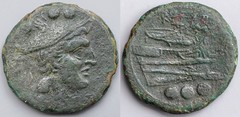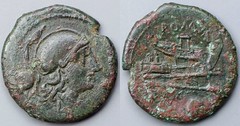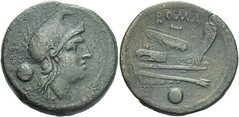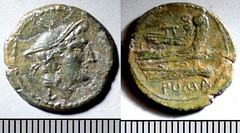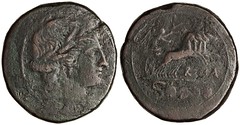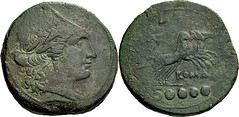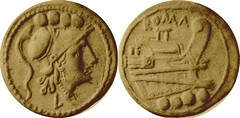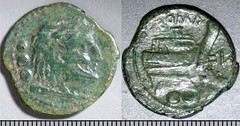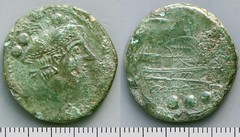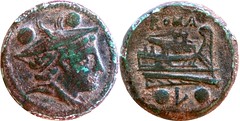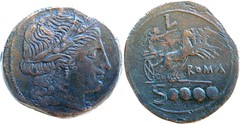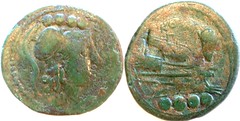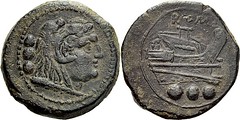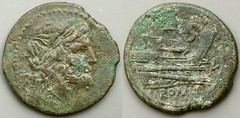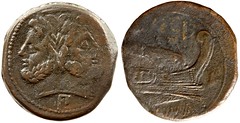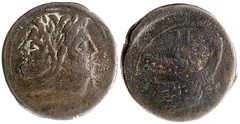Roman Coins of Luceria and Canusium, arrangement M.H. Crawford, RRC, with comments

|
Roman Coins of Luceria and Canusium, arrangement M.H. Crawford, RRC, with commentary
- General Introduction
- Luceria L - Crawford RRC 43
- Luceria L - Crawford RRC 97
- Luceria LT - Crawford RRC 98
- Luceria P - Crawford RRC 99
- Canusium CA - Crawford RRC 100
Coins of Luceria and Canusium, arrangement M.H.Crawford, RRC, Introductory comments
The purpose of this web-site is to provide illustrated examples of all the RRC varieties of the coins of Luceria (Lucera in modern Italy) and Canusium (Canosa in modern Italy), and thereby to provide a baseline for further study of the series. This presentation should help people to identify coins in this notoriously difficult series. The catalogue should be read alongside Roman Republican Coinage, Michael H. Crawford, Cambridge, 1974, to which the catalogue numbers refer.
The coin descriptions note characteristics of their designs which should serve as a basis for a future classification. For example, there are a number of coins which are described as having 'bulbous prowstems', which have a star engraved on the side of the prow, and which are of consistently heavy weight standard, are of a common engraving style, and all have thick flans. There is another group of Luceria L types, again of heavy weight, that are always struck on broad thin flans, and that have very different engraving style and design characteristics (for example, placement of mintmarks, shape of prow) when compared with the 'bulbous prowstem' group, but that have very close links to the coinage of the RRC 98 LT series. In a future reclassification of these coins, I would be minded to group coins together based on such characteristics. I have also noted many minor varieties of the coinage that were not specifically identified in RRC. In many cases these varieties can be subsumed under an existing RRC number. In other cases I have felt it necessary to introduce additional numbers, for example my new group RRC 97B, for types not included in RRC.
However the purpose of these web-pages is not (yet) to reclassify, but to present the coinage exactly as classified by Michael Crawford in RRC. This should be regarded as a baseline study.
Please refer to the main introduction for additional comments and photo credits.
- General Introduction
- Luceria L - Crawford RRC 43
- Luceria L - Crawford RRC 97
- Luceria LT - Crawford RRC 98
- Luceria P - Crawford RRC 99
- Canusium CA - Crawford RRC 100
Luceria L RRC97, arrangement M.H Crawford, RRC, with commentary
Refer: RRC pp.183-187 (main entry); RRC pp.19 (dating); RRC Appendix 39*, 129*, 143*; d'Ailly vol.ii, 660, 784, pl.lvii,7-9; Sydenham 121-121a, 126-127, 176, 178-180, 304-305; K.Samwer and M. Bahrfeldt, Geschichte, pl.4,16; G.de Petra, Rendiconto Napoli 1887,19; M.Bahrfeldt, Blätter für Münzfreunde 1930-33,681; C.H.V.Sutherland, NC 1938,129.
The catalogue is formatted as a list of coin photos, with descriptions, in the order of Crawford RRC. I only comment when essential to illuminate varieties or missing types. The reader should consult Crawford RRC for additional information.
97-1a Luceria L Victoriatus. Roman mint. Jupiter; Victory L Trophy. Paris d'Ailly 3188, 3g27
This variety has straggling hairlocks
97/1b Luceria L Victoriatus. Roman mint. Jupiter; Victory L Trophy. ACM#1093-33, 3g33
This variety has three falling ringlets. The difference in hairstyle between RRC 97/1a (straggling hair) and RRC 97/1b (three ringlets), is not always sufficiently clear on examples I have seen, to make a clear distinction. Sometimes the ringlets are rather straggling...
97/2 Luceria L Quinarius. Roman mint. V Roma; Dioscuri / L / ROMA. Davis collection.
RRC Group 2 (for earlier bronzes see RRC 43), RRC 97/3 to RRC 97/8, weight noted in RRC, 64 grams.
97/3, Luceria L Quincunx. Italian civic mint. L Apollo; Dioscuri / ROMA / ooooo. Heavy issue, all known examples above 24g. RR 25g12
The typology links with the LT series and other coins of my 'Italian civic mint' group causes me to group the Dextans and Quincunx with those coins. On weights, it should be noted that the heaviest Quincunx (this, RRC 97/3) averages two-third the weight of the heaviest Dextans (RRC 97/9) and that the lighter examples of both (RRC 97/11, RRC 97/16) average two-thirds the weight of the heavier, i.e. a light Dextans weighs about the same as a heavy Quincunx. For both denominations the weights are bimodal, i.e. there is a distinct gap between heavy and light coins, yet in both cases some, but not all, dies are shared between the heavy and light coins. All these facts lead me to consider the Dextans as token coinage weighing one and a half times the Quincunx, and the actual standard weights may have been one-and-a-half-ounce and one ounce, respectively. Both were at some time reduced in weight by exactly one-third. With their distinctive types there was little risk of the token-weight Dextans being confused with any other denominations. As the heavy Quincunx, 97/3, is heavier on average than the related 'Italian civic mint' Trientes, RRC 43/3b and RRC 43/3c, it seems possible that the Dextans and Quincunx formed, respectively, the Nummus and Half-Nummus in an Italian decimal system, as used in other southern Italian cities at the time.
97/4 Luceria L Triens. Roman mint. oooo / L / Minerva; Prow, vertical stem / L / oooo. ACM#03143-23, 22g99
This is a Roman mint type with narrow vertical prowstem which apparently indicates a weight reduction step. I associate this type with the RRC 97/10 Semis, with the RRC 97/13a, 97/13b Quadrantes, and with the Sextans, Uncia and Semuncia types also having narrow vertical prowstems, and generally of reduced weights.
97/5a Luceria L Quadrans. Roman mint. Hercules / ooo; ROMA / Prow, star, bulbous stem / L / ooo. ACM#10246-18, 17g57. Evidently part of RRC43.
This is clearly to be associated with the bulbous prowstem types in RRC 43. The weights are also consistent with RRC 43.
97/5b Luceria L Quadrans. Roman mint. o / Hercules / oo; ROMA / Prow, no star, angled narrow stem / Looo. RBW 22g18. Evidently part of RRC43
This is associated with the slanted prowstem types in RRC 43. It was certainly engraved by the same die-cutter that made the RRC 43/3a var. Triens with the same style prow. The weights of this type are typically between 20 and 25 grams. The RRC-cited Oxford specimen which weighs 15 grams shows heavy edge corrosion and may have caused Crawford to place this type with RRC 97 rather than with RRC 43 to which it properly belongs.
97/5c Luceria L Quadrans. Italian civic mint. oo / o / Mercury / L; Roma / Prow / ooo. Paris d'Ailly 3311, 15g06. Note die-break, which cuts across the deck structure more than on the lighter example below.
97/5c Luceria L Quadrans. Italian civic mint. o / oo / Mercury / L; Roma / Prow / ooo. AM#1017-11, 10g81. Rare Mercury-headed type, value mark split o-oo around his wing. This light example is from an earlier die-state.
There are two obverse varieties of the Mercury headed quadrans, identified by different placing of value-mark around Mercury's wing (either two dots left and one right oo-o, or two right and one left o-oo) as well as by different obverse and reverse engraving styles. I illustrate above, as RRC 97/5c, both a heavy and light example of the variety with value mark arranged o-oo around the wing, from the same die-pair. The RRC illustrated RRC 97/13d, pl.XVIII,5, Paris A3314, as well as the RRC cited RRC 97/5c, Paris A3309, both have this value mark placement and are of the same style. There is a die break on one reverse die that occurs at all weights but is most prominent and presumably late in the above Paris A3311, a heavy example at 15.06 grams. I illustrate a lighter example from this die-pair, AM1017, 10.81 grams, and its die break is earlier, not breaking through the right-hand upright of the deck structure in the manner of A3311. I have seen 30 examples of the Mercury head Quadrans, of both varieties: there is a weight peak around 12 grams and then a skewed longer tail to the right of the peak. Nine of the ten heaviest examples are of the above illustrated o-oo variety. So I'm inclined to think that the above type is correctly placed as the heavier issue RRC 97/5c, and that the oo-o issue, of different obverse and reverse styles and not cited at all in RRC, should be considered the later RRC 97/13d, contra RRC pl.XVIII,8. It is not possible to make a distinction at the level of individual coins, considering both the spread of weight distribution and the above die-break example pair which proves a heavy coin followed a lighter one, but the overal statistics indicate that the above o-oo was first, and the oo-o issue illustrated as RRC 97/13d was second. The latter has an obverse style (if not die) that coincides with the Mercury-head Quadrans of the LT series, which may be a consideration in arrangement.
97/6a Luceria L Sextans. Italian civic mint. Mercury / L; ROMA / Prow / oo. AM#1332-98, 9g76
Note the wing under the middle wale, also present on the Mercury-head Quadrans. The mintmark under the head is very clear on this coin, but, given its edge location, is often weak or missing.
97/6b Luceria L Sextans. Roman mint. Mercury; ROMA / Prow, star, bulbous stem / oLo. RR 9g51
This bulbous prow-stem with star variant can be associated with earlier RRC 43 types with the same features.
97/7a Luceria L Uncia. Italian civic mint. o / Roma, attic helmet / L; ROMA / Prow / o. AM#10240-55, 20.5mm 5g46
97/7b Luceria L Uncia. Italian civic mint. o / Roma, phrygian helmet / L; ROMA / Prow / o. RR 6g07
I have examined 18 examples of RRC 97/7b, and all 18 examples are above sextantal weight, averaging 5.9 grams or an implied as weight of 71 grams, including 4.61g (Paris A3367), 4.88g (RBW coll.), 5.00g (A3365), 5.07g (BM), 5.25g (AM coll.), 5.32g (BM), 5.33g (RR coll.), 5.38g (RBW), 5.55g (Vecchi 17), 5.69g (Cambridge), 5.73g (A3362), 5.92g (A3361), 6.01g (A3360), 6.07g (RR), 6.14g (CNG), 6.21g (A3359), 7.38g (Hannover), 11.39g (RR), the last two having implied as weights of 89 grams and 137 grams. Thus 100% of examples exceed the supposed standard, which is hardly consistent with the comments throughout RRC of a complete inability to maintain bronze weight standards! I have to conclude that this type, as well as RRC 97/7a, are of an earlier period, associated with the Trientes RRC 43/3b and RRC 43/3c. Both are clearly associated by design with the Quinarii, RRC 98A/4 and RRC 98B/1.
97/8 Luceria L Semuncia. Italian civic mint. Mercury / L; sigma / Prow / L / ROMA. Paris d'Ailly 3386, 2g80
97/8 var. Luceria L Semuncia. Italian civic mint. Mercury / L; sigma / Prow / ROMA. Paris d'Ailly 3384, 3g52. No-mintmark variety is noted but not numbered in RRC.
RRC p.185 notes "sometimes before, L"; this is clearly a no-L example. Ordinarily this would merit a separate catalogue entry in RRC, hence I note as a variant.
- General Introduction
- Luceria L - Crawford RRC 43
- Luceria L - Crawford RRC 97
- Luceria LT - Crawford RRC 98
- Luceria P - Crawford RRC 99
- Canusium CA - Crawford RRC 100
RRC Group 3, RRC 97/9 to RRC 97/15, weight noted in RRC, 45 grams.
97/9 Luceria L Dextans. Italian civic mint. Ceres; L / Victory in quadriga / ROMA / Soooo. ANS 1944.100.194, 36g21.
97/9 Luceria L Dextans. Italian civic mint. Ceres; L / Victory in quadriga / ROMA / Soooo. RR 39g10.
I illustrate two of the three known Dextantes that weigh above 36 grams. The third is in Milan and can be seen in Belloni's catalogue. The 17 other examples I know all weigh below 30 grams, with none weighing between 30 and 36 grams, thus a clear bi-modal distribution. However the ANS example shares an obverse die with the below-illustrated RRC 97/16. The RR and Milan examples have a larger die-circle diameter. So it is unclear whether the ANS coin is an early type with a small die that was later re-used, or a later type on an unusually heavy flan.
97/10 Luceria L Semis. Roman mint. S / Saturn; S / Prow, star, vertical stem / L / ROMA. ACM#1058-22, 21g83
The prow has a vertical, narrow prowstem, as discussed under RRC 97/4 Triens. Examples of this type weigh exactly half that of the heavy struck RRC 43/2a Semis wiht bulbous prowstem. On other denominations having the same style and prow design the weight reduction is more modest, suggesting, as discussed under RRC 97/3 Quincunx, a degree of tokenisation of the bronze currency, with lower denominations being relatively heavier.
97/11 Luceria L Quincunx. Italian civic mint. L Apollo; Dioscuri / ROMA / ooooo. RR 18g28. Light issue, all known examples below 19g, but shares dies with RRC 97/3.
Note the reverse die match with RRC 97/3 above.
97/12 Luceria L Triens. Second phase. oooo / Minerva / L; ROMA / Prow / oooo. BM GLC 97.12.1, 15g15. Cited RRC 97/12 coin but identical to RRC 97/18.
RRC 97/12 apparently does not exist. Despite the heavy weight of this example, this coin is misplaced in the sequence and should belong to the coin series that starts with RRC 97/17 onwards. It is in fact identical to RRC 97/18 Triens, but I keep it in this position as it is the cited coin for RRC 97/12, which type may be deleted in a future arrangement.
97/13a Luceria L Quadrans. Roman mint. Hercules / ooo; ROMA / Prow, star, vertical stem / L / ooo. ACM#04103-10, 10g33
97/13b Luceria L Quadrans. Roman mint. L / Hercules / ooo; ROMA / Prow, star, vertical stem / L / ooo. ACM#1018-94, 9g37. Note mintmark behind head.
Two Quadrantes with vertical prowstems, one with an additional mintmark behind Hercules' head. These are to be associated with the RRC 97/4 Triens and RRC 97/10 Semis types.
97/13c Luceria L Quadrans. Italian civic mint. ooo / Hercules, club; ROMA / Prow, style as LT or Mercury issues / L / ooo. Paris d'Ailly 3297, 9g16
97/13c Luceria L Quadrans. Italian civic mint. ooo / Hercules, club; ROMA / Prow, style as LT or Mercury issues / L / ooo. RR 8g91
I illustrate two examples of this extremely rare Quadrans type, which are always struck on a broad thin flan measuring 25mm to 27mm diameter. The diameter is key to identifying for this type, which otherwise could be confused with the later RRC 97/19, struck on small thick flans about 20mm diameter, and of similar weight (6 to 9 grams). The prow design on RRC 97/13c is also similar to that on the Mercury-head Trientes.
97/13d Luceria L Quadrans. Italian civic mint. oo / o / Mercury / L; Roma / Prow / ooo. AM#11105-12, 11g96. Rare Mercury-headed type, value mark split oo-o around his wing.
See discussion under RRC 97/5c above. I place this variety with oo-o value arrangement, and a distinctive engraving style, as the second issue, because almost all of the heaviest Mercury Head Quadrantes are of the other o-oo value-mark variant and style. The RRC illustrated pl.XVIII,13 is an untypically light example of the other style and the above variant would be a better choice as illustration.
97/14 Luceria L Sextans. Roman mint. Mercury; ROMA / Prow, star, vertical stem / oLo. RR 6g04
Vertical prowstem type to be associated with RRC 97/4, 97/10, 97/13a, 97/13b.
97/14 var. Luceria L Sextans. Roman mint. Mercury; ROMA / Prow, angled stem / oLo. ACM#0290-76, 7g60. Prow style and obverse style variety.
This is an aberrant type which I cannot place in the regular Luceria coinage - no other coins of this weight in any denomination have a similar style prow; the square form of the letter L and the obverse design are also untypical. I have seen no other coins from these dies, and must defer consideration to a later date.
97/15 Luceria L Uncia. Roman mint. o / Roma; ROMA / Prow, vertical stem / Lo. ACM#0668-43, 17.5mm 4g33. NB RRC 97/21 does not exist.
The Uncia with narrow vertical prowstem; together with the variant Semuncia illustrated under RRC 43/6 this completes the grouping of these types. I have not seen the cited RRC 97/21 Uncia (Turin F664) but suspect it is likely a lightweight example of this type, and not associated with the general coinage from RRC 97/17 onwards.
- General Introduction
- Luceria L - Crawford RRC 43
- Luceria L - Crawford RRC 97
- Luceria LT - Crawford RRC 98
- Luceria P - Crawford RRC 99
- Canusium CA - Crawford RRC 100
RRC Group 4, RRC 97/16 to RRC 97/21, weight noted in RRC, 36 grams.
For reasons noted under the Quincunx and Dextans types listed above, I believe the split between the RRC Group 3 and Group 4 bronzes would be better placed at 97/17, since RRC 97/17, 97/18, 97/19 and 97/20 form a stylistically coherent group, unrelated to the RRC 97/16 Dextans.
97/16 Luceria L Dextans. Italian civic mint. Ceres; L / Victory in quadriga / ROMA / Soooo. RBW 21g19. Shares obverse die with heavy ANS example RRC 97/9.
Note comments under RRC 97/9 above. This is an obverse die match with the ANS example.
97/17 Luceria L Semis. Second phase. Saturn / L; S / Prow / ROMA. ACM#1333-15 14g87, overstrike on a post-semilibral triens, unpublished cf RRC Table XVIII.
With RRC 97/17 commences what I describe as the 'second phase' of Luceria coinage. From this point, all coins follow the 'Italian civic mint' manufacturing fabric and styles (notably prow design) the diameters of each denomination of the coinage have reduced, and the coinage now includes the As denomination but not the Dextans or Quincunx. There are no vestiges of the style or fabric that I termed 'Roman mint', and I presume the latter workshop or mint to have closed. These second phase coins are relatively thicker than the 'Italian civic mint' issues, a case in point being the contrast between RRC 97/13c (25-27mm) and RRC 97/19 (20mm) Quadrantes, of sometimes similar weights but dramatically different modules.
It is not yet fully clear how the 'second phase' should be further sub-divided. Crawford in RRC identifies a first group that includes Semis, Triens, Quadrans, Sextans and Uncia. I have not seen an Uncia of the first group. The first group is characterised by obverses having rounded features and invariably only a single mintmark - on the obverse of all denominations except the Quadrans. Some Asses with obverse mintmark appear stylistically linked to this first group - an example is shown under RRC 97/22a below. Crawford's second group includes As, Semis, Triens, Quadrans and Sextans. Compared with the first group, the designs are more compact with very refined engraving. The Asses either have reverse or obverse mintmarks; the Semis and Triens have mintmarks both sides; the group possibly includes a Quadrans, but not a Sextans - the cited Paris A3338 is terribly worn, not so light (4.5grams), and stylistically indistinguishable from examples of RRC 97/20.
97/18 Luceria L Triens. Second phase. oooo / Minerva / L; ROMA / Prow / oooo. RBW, Triens 9g53
As noted earlier, RRC 97/12 should be included here.
97/19 Luceria L Quadrans. Second phase. ooo / Hercules, club; ROMA / Prow / L / ooo. ACM#1015-89, 8g94
Contrast with the much larger diameter RRC 97/13c, of the same weight.
97/19 var. Luceria L Quadrans. Second phase. ooo / Hercules, club; ROMA / Prow / ooo. RR, 9g00. No mintmark variety.
This is an unpublished variety lacking any mintmark.
97/20 Luceria L Sextans. Second phase. oo / Mercury / L. ROMA / Prow / oo. AM#0577-56, 5g57. NB RRC 97/27 is identical.
There probably does not exist a separate RRC 97/27. My examination of the weights of 27 examples shows a single weight peak at about five grams, with 90% of coins clustered in a narrow range between 4 and 6 grams.
RRC 97/21 apparently does not exist
- General Introduction
- Luceria L - Crawford RRC 43
- Luceria L - Crawford RRC 97
- Luceria LT - Crawford RRC 98
- Luceria P - Crawford RRC 99
- Canusium CA - Crawford RRC 100
RRC Group 5, RRC 97/22 to RRC 97/27, weight noted in RRC, 23.5 grams.
97/22a obv.mm. Luceria L As. Second phase. horizontal bar Janus L; I Prow ROMA. RBW 25g52. This coin seem related to RRC 97/17 and other fractions.
Obverse mintmark. This relatively heavy coin seems to belong with RRC 97/17 to 97/20, considering both style and weight.
97/22a obv.mm. Luceria L As. Second phase. horizontal bar / Janus / L; I / Prow / ROMA. Paris d’Ailly 3232. Despite this being the cited RRC 97/28, it is a regular RRC 97/22a on a small light flan
Obverse mintmark. I illustrate this to correct the RRC citation of A3232 on p.187 - this is evidently a regular but lightweight RRC 97/22a.
97/22a obv.mm. Luceria L As. Second phase. horizontal bar Janus / L; I / Prow / ROMA. RR 17g52
Obverse mintmark.
97/22a rev.mm. Luceria L As. Second phase. horizontal bar / Janus; I / Prow / L / ROMA. ACM#1105-17, 16g52. Very rare with reverse mintmark, none in Paris.
Rare reverse mintmark.
97/24 Luceria L Semis. Second phase. Saturn / L; S / Prow / L / ROMA. AM#11207-13, 12g59. Mintmarks both obverse and reverse.
Both obverse and reverse mintmarks.
97/25 Luceria L Triens. Second phase. oooo / Minerva / L; ROMA / Prow / L / oooo. AM#11208-99, 9g91. Mintmarks both obverse and reverse.
Both obverse and reverse mintmarks.
97/26 Luceria L Quadrans. Second phase. ooo / Hercules, club; ROMA / Prow / L / ooo. ACM#0981-62, 6g24
Reverse mintmark.
RRC 97/27 apparently does not exist
RRC Group 6, RRC 97/28, weight noted in RRC, 9 grams.
97/28 Luceria L As. Fourth phase. Janus / L; I / Prow / ROMA. Apparent L below head. Paris d’Ailly 3549, 5g55. Incorrectly cited and illustrated as RRC 99/10 but the types were switched in RRC.
This coin is cited on RRC p.190 as RRC 99/10 and shown in RRC pl.XIX,19 as such. It appears to have an L mintmark under the obverse head but no mintmark on the reverse - just a scratch. The illustrated RRC 97/28 on RRC pl.XVIII,13 appears to have a P mintmark on the reverse but no mintmark on the obverse. So it appears the two coins were switched. This corrects the record. I separately note that I have not yet seen any other lightweight As with a mintmark.
- General Introduction
- Luceria L - Crawford RRC 43
- Luceria L - Crawford RRC 97
- Luceria LT - Crawford RRC 98
- Luceria P - Crawford RRC 99
- Canusium CA - Crawford RRC 100
97/22b Luceria P-L Coinage - Group 97B
The enigmatic Asses with both P and L mintmarks evidently link the mint of P with that of L but deserve separate comment, on both their designs and possible other denominations. I show three examples of the P-L As (one an enlargement of the Milan coin illustrated in RRC) and two examples of a possibly related Sextans.
97/B1 = 97/22b Luceria P-L As. Third phase. Janus / P; Pi, I / Prow / L / ROMA. Hannover 25g33
97/B1 = 97/22b Luceria P-L As. Third phase. Janus / P; Pi, I / Prow / L / ROMA. ANS 1944.100.73758 Newell 23g53
97/B1 = 97/22b Luceria P-L As. Third phase. Janus / P; Pi, I / Prow / L / ROMA. Naples 17g32. Detail showing mintmarks Π above prow and L before prow.
Until recently two examples of this type were known, in Hannover and Milan, however a third had lain unrecognised in the ANS. The three coins show different details that together tell the full story of the coin. The obverse type and prow details are best seen on the Hannover example, which however misses the details above the prow. The obverse is in the normal style of the P coinage, with upturned gaze. It may be possible to find a die-match with other coins of RRC 99/1. The reverse prow design is stylistically consistent with that on many RRC 97/22a coins (and does not relate to the P style coinage) but the Pi above the prow shows it is clearly a separate die - this cannot be a hybrid of RRC 97/22a and 99/1. Crawford suggests (RRC p.187,n.1) that the mark Pi is part of the prow structure but considering both the ANS and Naples coins I think it separate, and is probably intended as a Greek Pi mintmark, to match the P on the obverse. The L mintmark is shown clearly enough although worn on the ANS coin and seems to be of normal shape and the same small size and same position as the reverse mintmarks other RRC 97/22a or RRC 97/23 mintmarks; the apparent curve on the Milan examples is an illusion caused by surface effects. So, this type has a P obverse die, and a L-style reverse die with L mintmark and Pi above the prow.
97/B2 Luceria P-L Sextans. Third phase. oo, P / Mercury; ROMA / Prow / oLo, die-break over L. Paris Anciens Fonds 5g67. P behind head differs RRC 99/7, new type irrespective rev.mm reading.
97/B2 Luceria P-L Sextans. Third phase. oo, P / Mercury; ROMA / Prow / oLo. RR 6g49. P behind head differs RRC 99/7, new type irrespective rev.mm reading.
I place these two mysterious Sextantes alongside the P-L Asses, and hope that a third, clearer example, appears at some point. To be clear, these cannot be RRC 97/7 Sextans types as the latter have the mintmark under rather than behind the head of Mercury. Neither have a P shape mintmark on their reverse. The Paris example has a curve at the top of the mintmark and an L-shaped extension at the bottom. The RR example has an apparent L mintmark on the reverse (clearer in hand than in the photo). It is not clear what the reverse mintmark is, but from the Paris coin it appears an L crudely converted into a P. Whatever these coins are, P-L Sextans or a type of P Sextans with a very odd mintmark, they are unrecorded in either case.
- General Introduction
- Luceria L - Crawford RRC 43
- Luceria L - Crawford RRC 97
- Luceria LT - Crawford RRC 98
- Luceria P - Crawford RRC 99
- Canusium CA - Crawford RRC 100
All content copyright © 2004-2012 Andrew McCabe unless otherwise noted. If you've any questions or comments please contact me on the Yahoo Group RROME: http://groups.yahoo.com/group/RROME.
Alternately you can leave comments against any coin picture, just click on the picture and write in the comment box.
See my rarity estimates for Roman Republican Bronzes: Roman Republic Bronze Rarities..








